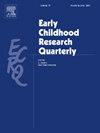越大越好公立蒙特梭利学前班的 CLASS 结果
IF 3.2
1区 教育学
Q1 EDUCATION & EDUCATIONAL RESEARCH
引用次数: 0
摘要
CLASS-PreK工具被广泛用于评估幼儿课堂,但对使用蒙台梭利这一世界上最常见的替代教育体系的课堂在CLASS中的表现却研究不足。由于 CLASS 主要侧重于作为学习场所的教师与儿童之间的互动,但在蒙特梭利理论中,儿童与环境之间的互动被认为是更主要的,因此蒙特梭利教室在 CLASS 中的得分可能会明显低于传统教室。CLASS还收集了形式、内容和人口统计信息,这些信息可以说明蒙特梭利课堂与其他课堂的比较情况。在此,我们利用首次全国性公立蒙特梭利学前教育研究的数据,对蒙特梭利学前教育教室的CLASS数据进行了研究,并与通过抽签控制选出的一组正常教室的CLASS数据进行了比较。蒙特梭利教室(n = 54)的儿童平均人数比一组有意分层的对照教室(n = 19,共 128 间)多 50%,儿童与成人的比例(大约 9 比 6)也高出很多,而 CLASS 分数在不同类型的教室中并无差异。在蒙台梭利教室里,孩子们参加集体活动的次数较少,而参加自由选择活动的次数较多;在蒙台梭利教室里,孩子们参与数学内容的次数也比对照组多。与直觉相反,但与蒙特梭利理论一致的是,班级人数较多(多达 26 人)的蒙特梭利教室的情感支持和课堂组织领域得分较高,而儿童与成人比例较高(多达 13:1)的教室的教学支持领域得分呈上升趋势。本文章由计算机程序翻译,如有差异,请以英文原文为准。
When bigger looks better: CLASS results in public Montessori preschool classrooms
The CLASS-PreK instrument is widely used to evaluate early childhood classrooms, but how classrooms using Montessori, the world's most common alternative education system, fare on CLASS is understudied. Because CLASS focuses largely on teacher-child interactions as the situs of learning, but in Montessori theory, child-environment interactions are considered more primary, Montessori classrooms may score systematically lower than conventional classrooms on CLASS. CLASS also collects format, content, and demographic information that could illuminate how Montessori classrooms compare to other classrooms. Here we used data from the first national study of public Montessori preschool to examine CLASS data in Montessori preschool classrooms as compared to a lottery-control-selected set of business-as-usual ones. Montessori classrooms (n = 54) had 50% more children on average, and significantly higher child:adult ratios (roughly 9 vs. 6) than a set of intentionally stratified control classrooms (n = 19 of 128), and CLASS scores did not differ across classroom types. Children in Montessori classrooms were observed in whole group activities during fewer cycles and in freely chosen activities during more cycles; also children were observed engaging with math content during more cycles in Montessori than in control classrooms. Counterintuitively, but consistent with Montessori theory, Montessori classrooms with larger class sizes (up to 26) had higher Emotional Support and Classroom Organization domain scores, and those with higher child:adult ratios (up to 13:1) trended towards higher Instructional Support domain scores.
求助全文
通过发布文献求助,成功后即可免费获取论文全文。
去求助
来源期刊

Early Childhood Research Quarterly
Multiple-
CiteScore
7.00
自引率
8.10%
发文量
109
期刊介绍:
For over twenty years, Early Childhood Research Quarterly (ECRQ) has influenced the field of early childhood education and development through the publication of empirical research that meets the highest standards of scholarly and practical significance. ECRQ publishes predominantly empirical research (quantitative or qualitative methods) on issues of interest to early childhood development, theory, and educational practice (Birth through 8 years of age). The journal also occasionally publishes practitioner and/or policy perspectives, book reviews, and significant reviews of research. As an applied journal, we are interested in work that has social, policy, and educational relevance and implications and work that strengthens links between research and practice.
 求助内容:
求助内容: 应助结果提醒方式:
应助结果提醒方式:


